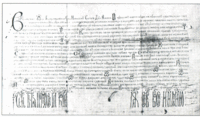Visoko during the Middle Ages

Archaeological excavations proved that the Visoko Valley was the center of a medieval Bosnian state and later kingdom. Many royal charters were written in Visoko and surrounding locations. Visoko Valley, as it is called today, included old royal town Visoki, its trade center Podvisoki, Mile, coronation and burial place for Bosnian bans and kings, and area of Moštre, where Bosnian Church institutions were located, including a university.
Visoko valley
Visoki
The royal town of Visoki was a fortress which existed during the time of the medieval Bosnian state. The first mention of the town happened on 1 September 1355, but it is believed to have been built even earlier. It was used by Bosnian bans and kings as a ruler's residence from which several official charters were written to other states. It was also defensively fortified, as the fortress had a trench and many towers of varying sizes. Visoki was first mentioned in a charter written in the royal town of Visoki, and was named in castro nosto Visoka vocatum. The charter was written by a young ban, Tvrtko I of Bosnia, who later became king in 1377 by his coronation in Mile. Several other rulers and nobles wrote charters in Visoki, including King Stephen Ostoja of Bosnia and Tvrtko Borovinić, who would be the last to write of the old town of Visoki in 1436 in the document on Visoki.

Visoki was built on Visočica hill, at a height of 766 meters, and 300 meters above the valley where the modern town of Visoko is located. By the time of the Turkish conquest of Bosnia, the old town was probably destroyed and never reconstructed. Few remnants of old Visoki remain, most being preserved in the town's museum. In situ evidence include the remains of foundations of the towers, walls and gates of Visoki. A model has been reconstructed according to plans of Đoko Mazalić made in 1953. The old royal town of Visoki is a national monument of Bosnia and Herzegovina. Today, beginning from 2007 its ruins are being slowly excavated so the town is becoming visible more and more.

Podvisoki
Podvisoki is a modern settlement in Visoko and was once a medieval subtown of the royal town. It was an important trade center and sometimes a ruler's residence. Podvisoki was one of the earliest examples of the medieval urban environments in Bosnia. In Podvisoki, a colony of Dubrovnik's merchants developed and maintained historically good relations with the Republic of Ragusa. The terms Bosnia and Podvisoki are often mentioned in Ragusan charters and documents. Biggest caravan shipment in medieval Bosnia happened in 1428 between Podvisoki and Dubrovnik. Often, term Bosnia would be identified with Podvisoki, which was one of the most important trade centres in country and located in core of Bosnian state.

Mile
Mile was first recorded in 1244 as the home of the Church of Saints Cosmas and Damian, a possession of the Bosnian bishopric. Around 1340, a Franciscan vicarage was established in Mile, the Franciscan monastery in the town being the first in Bosnia. The monastery is located by the modern settlement of Arnautovići on the right bank of the river Bosna. Mile was the coronation and burial place of Bosnian bans and kings during the medieval Bosnian state and was also the site where the Rusag was held. The first king of Bosnia, Tvrtko I Kotromanić, was crowned in Mile in Franciscan church St. Nikola, and later buried there alongside his uncle Stjepan II Kotromanić. An archive with important documents was also located in Mile.
Visoko's museum houses many artifacts founded by archeological excavations in the valley. One such expedition found a necropolis of stećak, some made in fine detail, including many materials, jewellery, tools, and other artifacts.
Moštre

There is not much detailed information about the medieval university in the Visoko area, referred to as the place called Bosnia by the Vatican archives. The university at Moštre was first mentioned in 1175 as a high academy of Bosnian religious organization (see Bosnian Church). The university was known for its scholarship in medicine, theology, cosmogony, and ethics. There are four documents that directly or indirectly point to the existence of the high academy in the Visoko Area.
In addition to its university, Moštre was the location of Bosnian church institutions including the house of krstjani. Also, Moštre was a place where charters were sometimes written; for example, in 1323, when ban Stjepan published his charter to Duke Vukoslav, and later in 1381, when king Tvrtko I Kotromanić issued a charter to Hrvoje Vukčić.
Other locations
In Biskupići, a plate of Kulin Ban dating from 1193 was found alongside remains of his church, grave, and foundations of buildings from that period. Other notable medieval settlements in the vicinity included Sebinje town, Čajan town in Gračanica—which protected the roads between Visoko and Bobovac—and the town of Bedem i Goduša.
See also
References
- Tarik Ahić, Ahmed Handžija, Munib Smajović (1998). Visoko, Guide through Visoko's economy and culture (Visoko, privredno-kulturni informator)
- Desanka Kovačević-Kojić, Sarajevo (1978). Town settlements of medieval Bosnian state
External links
- Text about Pavo Anđelić and his research works
- Francisian church in Mile
- Pictures and short description of Mile from official tourism board of Zenica-Doboj canton